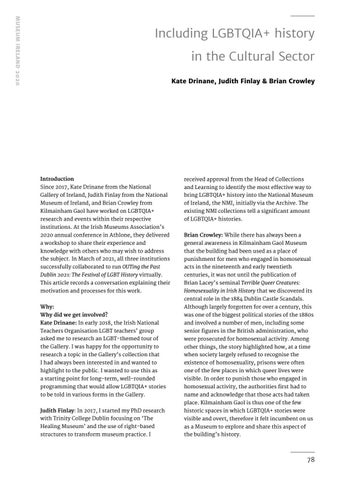MUSEUM IRELAND 2020
Including LGBTQIA+ history in the Cultural Sector Kate Drinane, Judith Finlay & Brian Crowley
Introduction
received approval from the Head of Collections
Since 2017, Kate Drinane from the National
and Learning to identify the most effective way to
Gallery of Ireland, Judith Finlay from the National
bring LGBTQIA+ history into the National Museum
Museum of Ireland, and Brian Crowley from
of Ireland, the NMI, initially via the Archive. The
Kilmainham Gaol have worked on LGBTQIA+
existing NMI collections tell a significant amount
research and events within their respective
of LGBTQIA+ histories.
institutions. At the Irish Museums Association’s 2020 annual conference in Athlone, they delivered
Brian Crowley: While there has always been a
a workshop to share their experience and
general awareness in Kilmainham Gaol Museum
knowledge with others who may wish to address
that the building had been used as a place of
the subject. In March of 2021, all three institutions
punishment for men who engaged in homosexual
successfully collaborated to run OUTing the Past
acts in the nineteenth and early twentieth
Dublin 2021: The Festival of LGBT History virtually.
centuries, it was not until the publication of
This article records a conversation explaining their
Brian Lacey’s seminal Terrible Queer Creatures:
motivation and processes for this work.
Homosexuality in Irish History that we discovered its central role in the 1884 Dublin Castle Scandals.
Why:
Although largely forgotten for over a century, this
Why did we get involved?
was one of the biggest political stories of the 1880s
Kate Drinane: In early 2018, the Irish National
and involved a number of men, including some
Teachers Organisation LGBT teachers’ group
senior figures in the British administration, who
asked me to research an LGBT-themed tour of
were prosecuted for homosexual activity. Among
the Gallery. I was happy for the opportunity to
other things, the story highlighted how, at a time
research a topic in the Gallery’s collection that
when society largely refused to recognise the
I had always been interested in and wanted to
existence of homosexuality, prisons were often
highlight to the public. I wanted to use this as
one of the few places in which queer lives were
a starting point for long-term, well-rounded
visible. In order to punish those who engaged in
programming that would allow LGBTQIA+ stories
homosexual activity, the authorities first had to
to be told in various forms in the Gallery.
name and acknowledge that those acts had taken place. Kilmainham Gaol is thus one of the few
Judith Finlay: In 2017, I started my PhD research
historic spaces in which LGBTQIA+ stories were
with Trinity College Dublin focusing on ‘The
visible and overt, therefore it felt incumbent on us
Healing Museum’ and the use of right-based
as a Museum to explore and share this aspect of
structures to transform museum practice. I
the building’s history.
78















